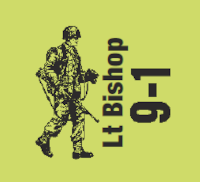
MMP changed the Mandatory Fire Group rule (A7.55) in ASL Journal 13. For ASL grognards, I doubt they even recognized the change since it codified the way we have been playing the game all along. Newer players probably didn’t notice it much either since we grognards probably taught you the “correct” way to play. It took a new player to ask why the rule and how we played were not in agreement.
Looking back into the history of the rule book, the passage remained unchanged all the way back to the initial 1st Edition of the rule book. When I dug into it, I recognized the issue and submitted a question to MMP. MMP examined the rule and issued a response and then issued errata in ASL Journal 13. What follows is an examination of the change and how to correctly apply the rule in your own games.
Rules Dive
We are looking at A7.55. The original rule began “If Good Order units/weapons in the same Location are going to fire at the same target (i.e., at both the same Location and the same unit and the same “simultaneous” [8.1] MF/MP expenditure; see D3.5) during the same phase they must form a FG …” We all looked at this for decades and played it how we played it, many of us never taking a moment to examine the rule. Had we done so, we would have probably noticed the problem sooner.
The Problem
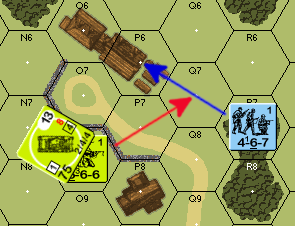
Referring to Figure 1, the German squad attempts to move via Q7, into P6. The American units in O8 wish to fire. In this example, it is important to note the German unit spends one MF in Q7. Could both units fire at the German movement in Q7? Before you decide; I encourage you to go back and read the original rule, especially you grognards out there.
Notice how the rule originally said “Good Order units/weapons firing at the same target (simultaneous MF/MP) must form a Fire Group”. I have condensed the language to make it easier to see but look for yourself before you go on. As originally written, one of the American units would have to forgo their shot.
We all played this wrong for decades. Perhaps the rule was wrong for decades, but as originally written, there was no exception to the rule just because the units couldn’t form a Fire Group. This is precisely what the errata fixed.
The New Rule
The rule now says “If units/weapons capable of forming a FG with each other in the same Location are going to fire at the same target (i.e., at both the same Location and the same unit and the same “simultaneous” [8.1] MF/MP expenditure; see D3.5) during the same phase they must form a FG”. Stated more succinctly as “if it can form a Fire Group, it must if it wants to fire”. I think this restatement makes the intent clear.
Referring to Figure 1, now the AFV and the squad can both fire at the German unit spending 1 MF in Q7. The errata now account for units incapable of forming a Fire Group where the original rule did not. I am sure this completely surprises some old hands out there. I know I was when I first recognized the problem.
What Does “Simultaneous” Mean
To understand this rule, you have to know what “simultaneous” means. It means MF spent at the same time. If a unit enters a building, the 2 MF spent to enter are spent “simultaneously”. If the same unit entered the same building and then attempted a Smoke grenade placement, the attempted Smoke dr would not be a “simultaneous” MF. Just because you can attack on each MF spent does not mean you can Fire Group on each MF spent. You will see where this is key in a moment.
Some Examples
What follows is not an exhaustive examination of every combination of Fire Grouping. For some of these examples, the number of options is lengthy. Nor is it intended to be an example of good play. I am trying to provide some good examples of Fire Grouping rules and not showing sound tactical advice.
Example 1
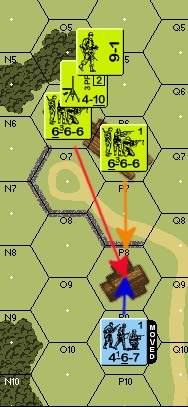
Refer to Figure 2. The German unit enters from off board, pushing into P8 for its last 2 MF. The American units elect to fire. What are their fire options?
The unit in P6 is the most straightforward. It could opt not to fire, waiting for a better target. Alternatively, it may Defensive First Fire (D1F) on the 3rd MF at 6 Fire Power (FP) with a +1 DRM (+2 TEM, -1 FFNAM). If the player wants, it could then Subsequent First Fire (SFF) on the 4th MF for a 2 +1. Of course, it could opt to forgo a SFF shot against this unit hoping for a better shot elsewhere.
The units in O6 are more complicated. Of course, they could opt not to fire and hope for a better shot later. They could opt to fire the MG on the 3rd MF. This prevents the squad from shooting since Mandatory Fire Grouping applies. The MG could shoot again on the 4th MF if it maintained Rate of Fire (ROF). If it did not get ROF, it could fire on the 4th MF as Sustained Fire. If fired as Sustained Fire, the possessing squad and the MMG are marked with a Final Fire counter (A8.3).
Simultaneous
The squad could opt to form a Fire Group with the MG or fire on its own. If it opts to fire with the MG on the 3rd MF, it could SFF on the 4th (again with the MG [but as Sustained Fire, regardless of whether ROF was retained or not]). Doing so would mark both the squad and the MG with a Final Fire counter (A8.3). Remember the discussion on “simultaneous” expenditure? If the squad chose to fire without the MG on the 3rd MF, it could not include the MG for a SFF attack on the 4th MF, since that would violate the Mandatory Fire Group rule’s “simultaneous” MF portion.
Both squads could opt to form a multi-Location Fire Group. They can mix D1F and SFF options between the units, including splitting their SFF shots between two IFT DR since they are not in the same Location. They can include the MG fire as long as it abides by the “simultaneous” expenditure rules. Keep in mind the Sustained Fire penalties if the possessing squad is already marked First Fire.
Per A7.53, a single leader cannot direct more than one weapon/unit per phase unless they are part of the same FG. Per A7.531, a leader may only direct fire from units in his Location. Other than these limits, the American 9-1 can direct any Fire Group in his Location. If he directs the MG, the leader can direct any subsequent ROF attacks. The leader’s direction can only apply to any FG–or sub-group of the original FG–he directed.
Example 2
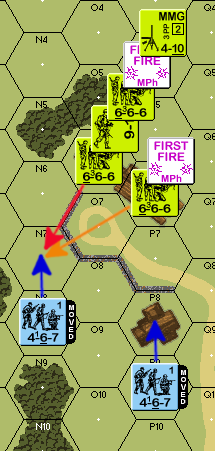
Refer to Figure 3. The Germans enter from off board. The first German squad entered P8. Subsequently, the American fires two separate Fire Groups with the MMG maintaining ROF. The stacks are marked with First Fire counters.
Now the second German unit enters the board and moves to N7. What are the American firing options? The unit in P6 could SFF alone. One or two of the squads in O6 could SFF alone. One or both squads in O6 could form a multi-Location Fire Group with P6 and fire together. Mark all firing units with Final Fire counters. Mark the MMG Final Fire if the squad possessing the MMG opts to fire, even if it does not fire the MMG.
Since the MMG maintained ROF, the leader could direct the ROF shot at N7 using his -1 DRM. But since the German unit only used a single MF entering N7, the squad possessing the MMG could not SFF at the same unit. The 9-1 could direct the shot of the possessing squad, or the other O6 squad since he was part of the initial Fire Group. If the American player opts to fire both squads and the MMG, the 9-1’s leadership would apply. The downside of this is that we treat the MMG’s fire as SFF (Sustained Fire) making the final shot 8 Fire Power. The important thing to note is the 9-1 continues to direct fire only for units/weapons which were part of the original group he directed.
Additional Examples
Imagine a scenario where the German unit moves into P8. The American squad with its MMG and the 9-1 opt to shoot on the 1st MF to no end. The other squad in O6 could not fire at the German unit as it entered P8—even on the second MF—since the Mandatory Fire Group rule applies per ‘the same “simultaneous” MF expenditure’—not per each individual MF spent. Now the second German unit moves into N7. The American 9-1 cannot direct a Fire Group comprising both squads in O6 since that would be a new Fire Group not made up of only units which he directed earlier. The leader can only direct fire of the squad possessing the MMG and the MMG from this point on.
Suppose both squads in O6 D1F on the 1st MF of the unit entering P8. Imagine they then elect to SFF. Since the 9-1 hasn’t been part of any Fire Group to this point, he could direct this SFF shot by joining the Fire Group. Mark the squads with a Final Fire counter and mark the leader with a First Fire counter.
Soap Box Moment

As an aside (looking at you David Garvin): don’t put your leaders in the middle of your stack like this. It just slows down play. Leaders belong on top of the stack. This is the way.
Example 3
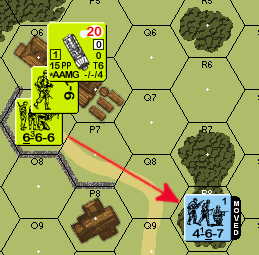
Refer to Figure 4. The German unit enters R8 for 2 MF. The Americans wish to fire on the 1st MF. The 9-1 and squad fire for no effect. Frustrated, the Americans now want to fire the halftrack (ht) on the 1st MF too. Is this allowed?
This is where the mantra “If it can form a Fire Group, it must” helps to clarify the situation. Per D6.64, Carriers and halftracks can Fire Group with Infantry and other Carriers and halftracks. Here, the ht could not fire due to Mandatory Fire Group limitations. We have seen this already, once this decision has been made, other units in the same Location cannot attack on the same “simultaneous” MF.
Now, imagine the German squad attempts to place a Smoke Grenade. This time, a new MF has been spent that was not part of the “simultaneous” expenditure on entry. Now the Americans could opt to fire the ht alone or in a Fire Group with the squad. Note the leader could not direct this second, new Fire Group since the ht was not part of the original Fire Group he directed. If the ht fires alone, the 9-1/squad combo could not fire due to Mandatory Fire Group limitations.
What Is Now Prevented
The original rule referred to “Good Order” units. This meant Berserk units and SW subject to Ammunition Shortage were not subject to Mandatory Fire Group limits. Now, if they can Fire Group, they must (if they want to fire). The old tactic of taking an initial shot with negative modifiers and waiting to see the outcome before applying a second shot with negative modifiers is now illegal.
An Odd Occurrence
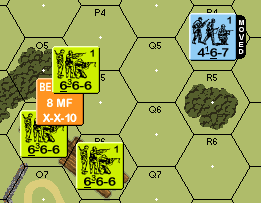
Another odd situation occurs when using a multi-Location Fire Group. Refer to Figure 5. The American units wish to fire on the German squad. If the units in O6 fire, they must form a Fire Group or forgo firepower from one of the American squads (if it can, it must).
Imagine instead, the Americans form a multi-Location Fire Group. Now, per A7.54, the Berserk unit cannot take part in a multi-Location Fire Group. Here, the Berserk unit cannot, but it COULD form a Fire Group with the other squad in its Location. As such, the Berserk unit would have to forgo its shot if the Americans form a multi-Location Fire Group.
The astute amongst you may already see this is practically a difference without distinction since all units are equal in this example. Other examples may be less balanced. Imagine if the Berserk unit possessed a .50 HMG for instance.
Conclusion

I have a confession to make. The first draft of this article was much different than its current appearance. I did not appreciate the meaning of “simultaneous” in the context of A7.55. As such, the article looked very different in this form. To be fair, I am still not convinced I am wrong but there is a Q&A supporting the interpretation presented in this article. I have included it as a footnote below.1 But this misunderstanding on my part is why I repeatedly hammer the “simultaneous” MF expenditure throughout this article.
There is much I have missed in this article. I was not attempting to be exhaustive in this examination. If you have additional questions, please leave a note in the discussion below. I will try to address your questions there. I will also pay attention to the discussion to see if there is a need for a further clarifying article so participation may generate more articles. Have a great week everyone.
A. Since the different target points are in the same Location, they are restricted by A7.55 as long as the target makes only one MF expenditure, which is usually the case for Infantry using bypass – even if they bypass 3-4 hexsides.
Q. Would this be any different if the vehicle were the unit using Vehicle Bypass?
A. Yes, because the vehicle makes a new MP expenditure per hexside traversed.
Q. Follow up to this. What if they spend more then one MF in the hex doing smoke grenade placement or crossing a hedge as they entered the bypassed hex? The MF is still spent in the bypassed hex (location) so would A7.55 still apply the same way as it would shooting at a unit in a woods location hex that spends 2 MF to enter?
A. That depends on whether it was a simultaneous expenditure (like crossing the hedge to enter the hex) in which case Mandatory FG still applies, or a separate expenditure (like attempting smoke grenades) in which case it does not.


I got a shout out! Oh, and I don’t hide my leaders like that anymore. Maybe during initial set up especially if I know I can conceal the stack.
You still need remedial training from time to time or you will fall back onto bad habits. I am here to keep you straight.
I need all the help I can get…
Thank you for keeping us honest! Welcome back to Virginia!
Garvin taught me that trick…
OK – this bit of the game is way more compicated than I thought……………
Not sure the rule required changing. From the Index and A.7, Good Order units are Personnel units and Good Order weapons are SW manned by a Good Order Personnel unit. A Gun is not a unit. An AFV is a unit but it is not a Personnel unit. Now there is a change in the game where Berserk units can now join same-hex FGs where previously they could not. Not a good thing IMO.
Even before the errata to A7.55 a berserk unit could be part of a same-Location FG, that hasn’t changed.
You are correct. My penultimate sentence is wrong. But what had been optional concerning Berserk units is now mandatory with the errata. An exception could have been made to keep the play of the game the same. The argument still remains that the original A7.55 does not create the problem as stated in the article because Good Order applies to a Personnel unit, a vehicular inherent crew or a SW (see the Index). It does not apply to the AFV or its weapons.
First, we both agree an AFV is a unit. That is not in dispute. From the index:
Good Order (a Personnel unit or vehicular inherent crew which is neither broken, berserk, captured, stunned, shocked, or held in Melee;
This is from the v2 Index. The v1 Index had this same passage word for word. Notice “vehicular inherent crew”.
A.7 GOOD ORDER: This term refers to a Personnel unit/inherent crew which is not broken, berserk, captured, stunned, shocked, or held in Melee.
This is from the v2 rule book. Again, inherent crew. The v1 rule book did not have “/inherent crew” in it but is otherwise a word for word copy. Even though v1 didn’t have the words “inherent crew”, it is clear the intent was regarding inherent crews given the words “stunned, shocked”. Those are the only units which can be stunned or shocked.
When those rules are taken as a whole, A7.55 in its original state, and as it appears in the v2 rule book, was applicable to both vehicles and Personnel units. If you doubt that, I refer you to D3.5 which speaks to vehicular MG/IFE and Mandatory FG restrictions.
As such, as originally written and as transcribed into the v2 rulebook, UNITS in the same Location–whether Personnel or vehicular–were subject to A7.55. I suggest you take a look at the rules again and make sure you’re reading the whole rule. I have quoted the relevant parts for this reply but I have not quoted the whole of the passages. This means either the rule was wrong or we played it wrong. Either way, the rule had to be clarified so we knew the intent. Either errata had to be issued to reflect the way we played the game or the intent needed to be clarified to stop us from playing the wrong way.
WRT Berserk units, I don’t really care one way or the other. I do find it silly that a Berserk unit–i.e. one that is lacking good order and discipline–was given more tactical flexibility than units possessing good order and discipline. But that smells like a reality argument. I am OK either way but I confess to agreeing with the rule as it is currently written.
D3.5 says all weapons on the AFV must form a FG with each other when shooting at the same target according to A7.55. I don’t think that is under dispute.
I distinguish between the inherent crew and the vehicle. The vehicle is a unit whether occupied or not. Good Order status applies to the inherent crew not the vehicle. The vehicle, as a unit, is not capable of Good Order status since it is not named in A.7 or the Index. Therefore, “Good Order units” in the original A7.55 did not encompass vehicles.
“Good Order ground units” does encompass vehicles, in which case the status is conferred on the vehicle according to the status of the inherent crew, (see A12.1).
We point to the same rules and read them differently. It doesn’t matter since A7.55 was changed.
It’s not about the Berserk unit per se. It is about respecting the game and its players. People put a lot of time and effort into learning the rules. Changing the rules, especially one that is 38 yrs. old, as opposed to clarifying it creates a new game. It also doesn’t help that these changes are not marked in the rulebook.
I do agree leaders belong on top. It simply saves time.
Unit: Any game piece or counter with its own MF/MP allotment and normally capable of movement without being portaged, pushed, or towed. Infantry, Cavalry [but not horses], Dummy stacks, and vehicles (even if Immobilized) are all different types of units.
An Abandoned AFV without a crew is no longer capable of movement. It is not a unit by rule. This was the same in the original version of the rules.
With all due respect, many of the rules you’re pointing to don’t say what you claim they say.
Changes in the rule book used to be marked in the margins with a large dot. I don’t know if this carried over to the v2 rules.
The dot indicating an update rule is still used on Replacement Pages.
Thanks Jim, welcome clarification and analysis on a problem that I (like many others) didn’t realise I had!
And sorry, but I’ll continue to keep my leaders on the bottom of stacks. They feel safer that way, even if in reality they’re not.
And I will continue to paw through your stack to identify them.
Hey Jim … you could always ask Andy to tell you where his leaders are, and let him do the counter fumbling! 😉
Leaders on top please.
I always put my leaders on the bottom and non-SW toting units on top. Don’t forget A12.16. If the opposing player does not have LOS to the stack he cannot inspect the stack. So why provide extra intelligence if you don’t need to? Sure, units out of LOS are often concealed, but not always. People forget things. Why remind them where my leaders and HMGs are? Make ’em ask. 🙂
My $0.02,
MikeS
I am well aware of the rule. Good players are going to know where they are already. Good players who don’t know, are going to ask you where they all are. If you deny that, then they are going to ask to inspect every stack in LOS. It’s all this back and forth that slows the game down.
You can stack as you see fit, of course. I would never force you to do otherwise. And who am I to tell you that you can’t give me all those free LOS checks on close stacks for Right of Inspection checks. It’s your call after all. There is no free lunch in ASL, You close one door, anther opens someplace else. 😉 Personally, I would rather have the LOS check anyway to know if my LOF is clear. So please, put them on the bottom 😉
If a stack is clearly in LOS it is good etiquette to put Leaders, then hero’s at the top of the stack. When not clearly in LOS anything goes.